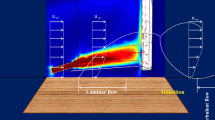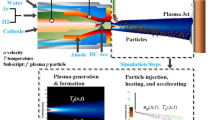Abstract
This research develops a method to estimate opaque coating thickness based on time-and-space-resolved thermography. Thermography is a viable technique for measuring coating thickness. However, time-resolved thermography becomes unreliable when uncontrolled constant thermal stimulation amplitude appears. Therefore, a time- and space-resolved thermography technique for coating thickness measurement called restored pseudo heat flux (RPHF) has been developed by using Fourier–Hankel transform. A non-dimensional analysis was conducted and the results show RPHF curves with different coating thicknesses converging as the thermal diffusivity ratio or thermal conductivity ratio goes to one. For large thermal conductivity ratio values, the RPHF curves have two inflection points along the non-dimensional radius. Fifty-nine samples were tested using the proposed method. Support vector regression (SVR) models were constructed with the in-plane distribution of RPHF and the temporal distribution of the measured surface temperature as inputs. To avoid overfitting, cross validation was applied to all the models. Later, another twenty-eight samples were tested to validate the SVR models. The results suggest that a support vector regression model with in-plane profiles of RPHF handles uncontrolled heat flux variation better and yields a better performance in coating thickness measurement than the temporal profile does. With in-plane RPHF profile as input, the SVR model can evaluate coating thickness with a relative root mean square error at 25.3% even when heat amplitude varies 50%.







Similar content being viewed by others
References
Bison, P.G., Cernuschi, F., Grinzato, E.: Ageing evaluation of thermal barrier coating: comparison between pulsed thermography and thermal wave interferometry. Quant. InfraRed Thermogr. J. 3(2), 169–181 (2006). https://doi.org/10.3166/qirt.3.169-182
Osiander, R., Spicer, J.W.: Time-resolved infrared radiometry with step heating. A review. Revue Générale de Thermique 37(8), 680–692 (1998). https://doi.org/10.1016/S0035-3159(98)80046-9
Aamodt, L., Spicer, J.M., Murphy, J.: Analysis of characteristic thermal transit times for time-resolved infrared radiometry studies of multilayered coatings. J. Appl. Phys. 68(12), 6087–6098 (1990). https://doi.org/10.1063/1.346897
Reimche W, Duhm R (2006) Non‐destructive testing and assessment of coatings. Modern Surface Technology:297-321. https://doi.org/10.1002/3527608818.ch19
Pilla, M., Klein, M., Maldague, X., Salerno, A.: New absolute contrast for pulsed thermography. In: Proceedings of QIRT (2002)
Omar, M., Hassan, M., Saito, K., Alloo, R.: IR self-referencing thermography for detection of in-depth defects. Infrared Phys. Technol. 46(4), 283–289 (2005). https://doi.org/10.1016/j.infrared.2004.04.005
Mackey RME (1997) Soap film thickness imaging by infrared methods
Cogdill, R.P., Forcht, R.N., Shen, Y., Taday, P.F., Creekmore, J.R., Anderson, C.A., Drennen, J.K.: Comparison of terahertz pulse imaging and near-infrared spectroscopy for rapid, non-destructive analysis of tablet coating thickness and uniformity. Journal of Pharmaceutical Innovation 2(1–2), 29–36 (2007). https://doi.org/10.1007/s12247-007-9004-0
Parvataneni R (2009) Principal component thermography for steady thermal perturbation scenarios. Clemson University,
Legaie D, Pron H, Bissieux C, Blain V Thermographic application of black coatings on metals. In: 9th International Conference on Quantitative InfraRed Thermography Krakow, Poland, 2008. vol 2. p 5
Sun, J.: Analysis of pulsed thermography methods for defect depth prediction. J. Heat Transfer 128(4), 329–338 (2006)
Decker, C.A., Mackin, T.J.: Measuring film thickness using infrared imaging. Thin Solid Films 473(2), 196–200 (2005). https://doi.org/10.1016/j.tsf.2004.04.058
Chirtoc M, Gibkes J, Walther H, Christ A, Antoniow J, Bicanic D, Bozoki Z, Szabo G, Bein B, Pelzl J Comparative study of coating thickness determination in packaging composite materials using photothermal radiometry, photoacoustic and photopyroelectric methods. In: Analytical Sciences/Supplements Proceedings of 11th International Conference of Photoacoustic and Photothermal Phenomena, 2002. The Japan Society for Analytical Chemistry, pp s185-s188
Larkin, L., Smoyer, J., Norris, P.: Laser repetition rate in time-domain thermoreflectance techniques. Int. J. Heat Mass Transf. 109, 786–790 (2017). https://doi.org/10.1016/j.ijheatmasstransfer.2017.02.047
Fisk TE (2017) Coating inspection method. Google Patents,
Rosencwaig A, Opsal J (1985) Thin film thickness measurement with thermal waves. Google Patents,
Commandre, M., Roche, P.: Characterization of optical coatings by photothermal deflection. Appl. Opt. 35(25), 5021–5034 (1996). https://doi.org/10.1364/AO.35.005021
Al Mohtar, A., Tessier, G., Ritasalo, R., Matvejeff, M., Stormonth-Darling, J., Dobson, P.S., Chapuis, P.O., Gomès, S., Roger, J.P.: Thickness-dependent thermal properties of amorphous insulating thin films measured by photoreflectance microscopy. Thin Solid Films 642, 157–162 (2017). https://doi.org/10.1016/j.tsf.2017.09.037
Yamane, T., Nagai, N., S-i, Katayama, Todoki, M.: Measurement of thermal conductivity of silicon dioxide thin films using a 3ω method. J. Appl. Phys. 91(12), 9772–9776 (2002). https://doi.org/10.1063/1.1481958
Yamane, T., Si, Katayama, Todoki, M., Hatta, I.: Thermal diffusivity measurement of single fibers by an ac calorimetric method. J. Appl. Phys. 80(8), 4358–4365 (1996). https://doi.org/10.1063/1.363394
Cernuschi, F., Bison, P., Figari, A., Marinetti, S., Grinzato, E.: Thermal diffusivity measurements by photothermal and thermographic techniques. Int. J. Thermophys. 25(2), 439–457 (2004). https://doi.org/10.1023/B:IJOT.0000028480.27206.cb
Bison, P., Cernuschi, F., Grinzato, E., Marinetti, S., Robba, D.: Ageing evaluation of thermal barrier coatings by thermal diffusivity. Infrared Phys. Technol. 49(3), 286–291 (2007). https://doi.org/10.1016/j.infrared.2006.06.019
Toivanen, J.M., Kolehmainen, V., Tarvainen, T., Orlande, H.R.B., Kaipio, J.P.: Simultaneous estimation of spatially distributed thermal conductivity, heat capacity and surface heat transfer coefficient in thermal tomography. Int. J. Heat Mass Transf. 55(25), 7958–7968 (2012). https://doi.org/10.1016/j.ijheatmasstransfer.2012.08.024
Toivanen, J.M., Tarvainen, T., Huttunen, J.M.J., Savolainen, T., Orlande, H.R.B., Kaipio, J.P., Kolehmainen, V.: 3D thermal tomography with experimental measurement data. Int. J. Heat Mass Transf. 78, 1126–1134 (2014). https://doi.org/10.1016/j.ijheatmasstransfer.2014.07.080
Toivanen, J.M., Tarvainen, T., Huttunen, J.M.J., Savolainen, T., Pulkkinen, A., Orlande, H.R.B., Kaipio, J.P., Kolehmainen, V.: Thermal tomography utilizing truncated Fourier series approximation of the heat diffusion equation. Int. J. Heat Mass Transf. 108, 860–867 (2017). https://doi.org/10.1016/j.ijheatmasstransfer.2016.12.060
Movahedian, B., Boroomand, B.: The solution of direct and inverse transient heat conduction problems with layered materials using exponential basis functions. Int. J. Therm. Sci. 77, 186–198 (2014). https://doi.org/10.1016/j.ijthermalsci.2013.10.021
Kaipio, J.P., Fox, C.: The Bayesian framework for inverse problems in heat transfer. Heat Transfer Eng. 32(9), 718–753 (2011). https://doi.org/10.1080/01457632.2011.525137
Wang H, Hsieh S-J Estimating non-metallic coating thickness using artificial neural network modeled time-resolved thermography: capacity and constraints. In: SPIE Sensing Technology+ Applications, 2014. International Society for Optics and Photonics, pp 91050 K-91050 K-91059
Wang, H., Hsieh, S.-J., Peng, B., Zhou, X.: Non-metallic coating thickness prediction using artificial neural network and support vector machine with time resolved thermography. Infrared Phys. Technol. 77, 316–324 (2016). https://doi.org/10.1016/j.infrared.2016.06.015
Wang, H., Hsieh, S.-J., Stockton, A.: Evaluating the performance of artificial neural networks for estimating the nonmetallic coating thicknesses with time-resolved thermography. Opt. Eng. 53(8), 083102–083102 (2014)
Poularikas, A.D.: Transforms and applications handbook. CRC Press, Piscataway (2010)
Moorhead MS (2009) Estimating the thermal properties of thin film and multilayer structures using photothermal deflection spectroscopy. Cornell University,
Shendeleva, M.L.: Thermal wave reflection and refraction at a plane interface: two-dimensional geometry. Physical Review B 65(13), 134209 (2002). https://doi.org/10.1103/PhysRevB.65.134209
Rantala, J., Wu, D., Busse, G.: NDT of polymer materials using lock-in thermography with water-coupled ultrasonic excitation. NDT and E Int. 31(1), 43–49 (1998). https://doi.org/10.1016/S0963-8695(97)00021-2
Zauner G, Mayr G, Hendorfer G Wavelet-based subsurface defect characterization in pulsed phase thermography for non-destructive evaluation. In: IS&T/SPIE Electronic Imaging, 2009. International Society for Optics and Photonics, pp 72480D-72480D-72488
Hongjin Wang S-JH, Peng Bo, Xunfei Zhou (2017) Restored Pseudo Heat Flux (RPHF) Algorithm for Carbon Fiber Composite Defect Detection Using Thermography under Uneven Heating. Quantitative InfraRed Thermography Journal. https://doi.org/10.1080/17686733.2017.1417807
ASTM (2014) Standard test methods for measuring and compensating for emissivity using infrared imaging radiometers. ASTM International, West Conshohocken (2014). doi, vol ASTM E1933-14
Thissen, U., Van Brakel, R., De Weijer, A., Melssen, W., Buydens, L.: Using support vector machines for time series prediction. Chemometrics and intelligent laboratory systems 69(1), 35–49 (2003). https://doi.org/10.1016/S0169-7439(03)00111-4
Al-Balushi, K., Samanta, B.: Gear fault diagnosis using energy-based features of acoustic emission signals. Proceedings of the Institution of Mechanical Engineers, Part I: Journal of Systems and Control Engineering 216(3), 249–263 (2002)
Mohandes, M., Halawani, T., Rehman, S., Hussain, A.A.: Support vector machines for wind speed prediction. Renewable Energy 29(6), 939–947 (2004). https://doi.org/10.1016/j.renene.2003.11.009
Huang, C.-L., Chen, M.-C., Wang, C.-J.: Credit scoring with a data mining approach based on support vector machines. Expert Syst. Appl. 33(4), 847–856 (2007). https://doi.org/10.1016/j.eswa.2006.07.007
Acharya, U.R., Ng, E., Tan, J.-H., Sree, S.V.: Thermography based breast cancer detection using texture features and support vector machine. J. Med. Syst. 36(3), 1503–1510 (2012). https://doi.org/10.1007/s10916-010-9611-z
Funding
Funding was provided by Texas A and M - CONACyT Program (Grant No. 230308).
Author information
Authors and Affiliations
Corresponding author
Appendices
Appendix 1: Derivation of RPHF and Dimensional Analysis
To provide background about the underlying theory in this paper, the derivation of RPHF is shown below. First, by applying Fourier transform with respect to t, r, and θ respectively, Eqs. (1–5) can be transformed into frequency domain as :
With boundary conditions set as:
Equations (12) and (13) are solved using:
According to (17):
By adding (18) (19) and (20) to Eqs. (14) (15) and (16), the following equations are obtained:
When Eq. (22) is added to Eq. (23), A and B are expressed as:
Define \( R\left( {\xi ,{\text{i}}}\omega \right) \) as the ratio between A and B:
where \( \chi = \frac{{k_{2} }}{{k_{1} }} \) and \( n = \sqrt {\frac{{\alpha_{1} }}{{\alpha_{2} }}} . \)
Add Eqs. (25) (24) and (26) to Eq. (21):
At the surface of coating z = − d0, one can obtained:
A dimensional analysis should be applied to Eq. (31) in order to test whether the derivation is consistent with previous studies. The unit of v1 can be calculated from Eq. (31) by knowing that
The dimension of the term R, \( \sqrt {{\xi^{2}} + \frac{i\omega }{\alpha }} \) can be derived:
The dimension of v1 should be
Besides, as the thermal effusivity is defined as \( e = \sqrt {\rho ck} \) while thermal diffusivity is defined as \( \alpha = \frac{k}{\rho c}, \) the Eq. (31) can be rewritten as:
with R defined as:
Appendix 2: Measured Thickness for Each Sample
The coating thickness δc is determined from measured sample thickness δs and foil thickness δf as
Therefore, the standard deviation of coating thickness δc as
Rights and permissions
About this article
Cite this article
Wang, H., Hsieh, SJ. Solving the Inverse Heat Conduction Problem in Using Long Square Pulse Thermography to Estimate Coating Thickness by Using SVR Models Based on Restored Pseudo Heat Flux (RPHF) In-Plane Profile. J Nondestruct Eval 37, 78 (2018). https://doi.org/10.1007/s10921-018-0535-8
Received:
Accepted:
Published:
DOI: https://doi.org/10.1007/s10921-018-0535-8






